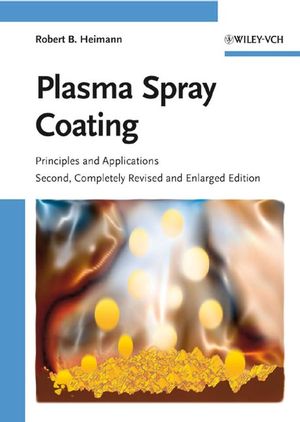Plasma Spray Coating: Principles and Applications, 2nd EditionISBN: 978-3-527-32050-9
Hardcover
449 pages
June 2008
 |
||||||
I. Scope and Introduction
Coatings in the Industrial Environment
Surface Coating Techniques
Brief History of Thermal Spraying
Synergistic Nature of Coatings
Applications of Thermally Sprayed Coatings
II. Principles of Thermal Spraying
Characterization of Flame versus Plasma Spraying
Concept of Energy Transfer Processes
Unique Features of the Plasma Spray Process
III. The First Energy Transfer Process: Electron-Gas Interaction
The Plasma State
Plasma Generation
Design of Plasmatrons
Plasma Diagnostics: Temperature, Enthalpy, and Velocity Measurements
IV. The Second Energy Transfer Process: Plasma-Particle Interaction
Injection of Powders
Feed Material Characteristics
Momentum Transfer
Heat Transfer
Particle Diagnostics: Velocity, Temperature, and Number Densities
V. The Third Energy Transfer Process: Particle-Substrate Interaction
Basic Considerations
Estimation of Particle Number Density
Momentum Transfer from Particles to Substrate
Heat Transfer from Particles to Substrate
Coating Diagnostics: Microstructure, Porosity, Adhesion, and Residual Stresses
VI. Modeling and Numerical Simulation
Plasma Properties
Plasma-Particle Interactions
Plasma-Substrate Interactions
VII. Solutions to Industrial Problems (1): Structural Coatings
Carbide Coatings
Nitride Coatings
Oxide Coatings
Metallic Coatings
Diamond Coatings
VIII. Solutions to Industrial Problems (2): Functional Coatings
Thermal and Chemical Barrier Coatings
Conducting and Superconducting Coatings
Dielectric Coatings
Electro- and Photocatalytic Coatings
IX. Solution to Medical Problems: Bioceramic Coatings
Essential Properties of Bioconductive Coatings
Structure and Crystal Chemistry of Hydroxyapatite
Melting, Decomposition, and Solidification of Hydroxyapatite
Bioinert Bond Coats
In Vitro and In Vivo Performance of Coatings
X. Quality Control and Assurance Procedures
XI. Design of Novel Coatings
XII. Future Developments and Outlook
Appendices
Coatings in the Industrial Environment
Surface Coating Techniques
Brief History of Thermal Spraying
Synergistic Nature of Coatings
Applications of Thermally Sprayed Coatings
II. Principles of Thermal Spraying
Characterization of Flame versus Plasma Spraying
Concept of Energy Transfer Processes
Unique Features of the Plasma Spray Process
III. The First Energy Transfer Process: Electron-Gas Interaction
The Plasma State
Plasma Generation
Design of Plasmatrons
Plasma Diagnostics: Temperature, Enthalpy, and Velocity Measurements
IV. The Second Energy Transfer Process: Plasma-Particle Interaction
Injection of Powders
Feed Material Characteristics
Momentum Transfer
Heat Transfer
Particle Diagnostics: Velocity, Temperature, and Number Densities
V. The Third Energy Transfer Process: Particle-Substrate Interaction
Basic Considerations
Estimation of Particle Number Density
Momentum Transfer from Particles to Substrate
Heat Transfer from Particles to Substrate
Coating Diagnostics: Microstructure, Porosity, Adhesion, and Residual Stresses
VI. Modeling and Numerical Simulation
Plasma Properties
Plasma-Particle Interactions
Plasma-Substrate Interactions
VII. Solutions to Industrial Problems (1): Structural Coatings
Carbide Coatings
Nitride Coatings
Oxide Coatings
Metallic Coatings
Diamond Coatings
VIII. Solutions to Industrial Problems (2): Functional Coatings
Thermal and Chemical Barrier Coatings
Conducting and Superconducting Coatings
Dielectric Coatings
Electro- and Photocatalytic Coatings
IX. Solution to Medical Problems: Bioceramic Coatings
Essential Properties of Bioconductive Coatings
Structure and Crystal Chemistry of Hydroxyapatite
Melting, Decomposition, and Solidification of Hydroxyapatite
Bioinert Bond Coats
In Vitro and In Vivo Performance of Coatings
X. Quality Control and Assurance Procedures
XI. Design of Novel Coatings
XII. Future Developments and Outlook
Appendices



